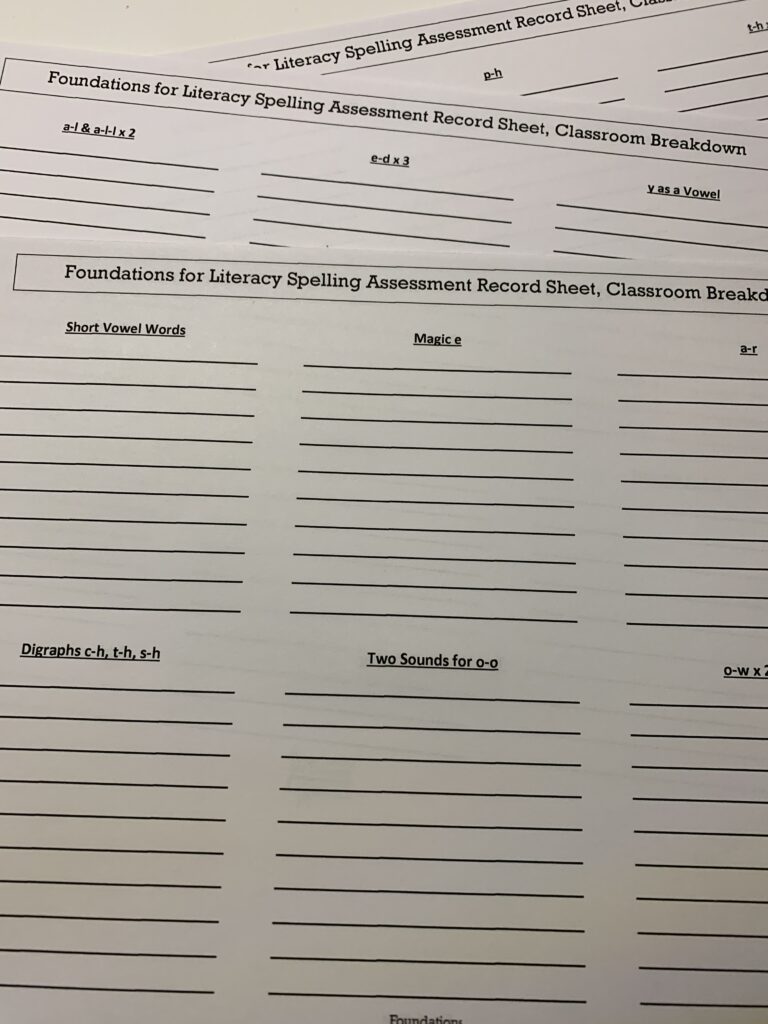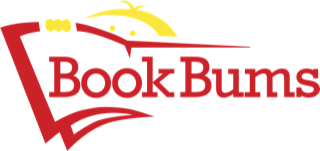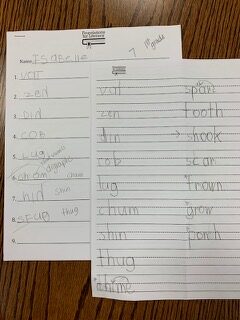Since it’s usually crazy returning from a break and getting back into those classroom routines, this is the perfect time to try something new—something that can absolutely transform your students’ reading and spelling skills.
Day 1, Back in the Classroom
On the very day you arrive back in your classroom, please set aside 15 minutes to ask you students to spell the words on the spelling assessment that I’m including in this post.
Explain to your students that they’re not supposed to know how to spell these words. In fact, there may be a few words that they’ve never even heard before. That’s okay. Be sure your students understand that they won’t be getting a grade. Rather, explain that you want to see what they know about how words work and that you want them to quietly make the sounds in the words and represent those sounds with letters as they spell each word. “No worries. Just do your best.”
A Simple Spelling Assessment Reveals Needed Instruction
- As you say each word, be very deliberate in your enunciation. Remind your students that it’s a good idea to look at your mouth when you call each word. Be sure to provide a sentence that reveals the meaning of each word you call so your students are exposed to a few new words that may broaden their vocabularies a bit. Finally, when kids begin making a handful of spelling errors or if students become frustrated, stop the assessment and collect their work.
- Take a quick glance at the assessments. Are your students using proper letter formations? Are they using the only lowercase letters? Are there letter reversals? Are all letters the same size or are the tall letters (d, f, t) taller than the small letters (a, e, s)? Do the appropriate letters “hang down” below the baseline (g, p, y)? If your students have poor penmanship, please watch for an upcoming post that shares how you can transform your students’ handwriting in just five lessons, across one week. (Think: One week of writing lesson plans— done!) It’s so much fun, and your students will actually begin believing that with focused, deliberate practice they can experience a transformation. (Think: Growth Mindset)
- Note where your students’ first spelling errors are. You do not need to “grade” these papers. Simply notice:
- Does everyone have their short vowels nailed down? If not, record the names of those students who need some extra practice nailing down the short vowel sounds.
- Are all students using the digraphs c-h, t-h, and s-h correctly? If not, record the names of the students who had some errors.
- Did everyone use a “Magic e” when spelling the 9th and 10th words? If not, record the names of students who had errors.
- How about the two sounds for o-o? Who had their first error with these words? Record those names in the next column.
- As you observe the assessments, you may use my classroom record sheet to record the names of the students on the lines under the skill where their first errors were made. This is not necessary. You can simply write the names on a blank piece of paper or right on the spelling assessment word list.
What Skills are Your Students Using but Confusing?
Here’s the most important part: If nearly one third of the class missed the same word(s), you now know the first foundational lesson that you need to teach the whole class. It does not matter that many of the kids spelled the words correctly. They will benefit from the lessons you’re beginning with, too. And I will make the lessons you present so much fun, that the review isn’t offensive in any way.

Sometimes it’s the kids for whom you may worry that a lesson is too easy that benefit most because there are words these kids have never seen before and they may actually learn to “make the sounds they see” rather than taking a quick glance and guessing. “Just knowing” words is not as beneficial as having command of the code upon which our language is based.
Also, many lessons have basic and extension words, so you can differentiate the words within the same lesson if you’d like.
If you have a handful of students who need instruction with more basic skills, you will still include those children in your whole class lessons, but you’ll offer instruction on the skills they need in a small group lesson in another part of your day. (I’ll share how that is to be done, soon.)
Academic Partners
One more tip: In my classroom, I like to assign “Academic Partners” for each student. Academic Partners may be like-skilled classmates and/or they may be stronger & weaker skilled classmates. You may choose what works best for you and your students. It may help to have like-skilled partners, initially. That way the more-skilled partners can watch one another to ensure accurate reading, and the less-skilled partners can sit near one another (knowingly or not) where you can support and guide them to ensuring accurate reading. The Foundations for Literacy curriculum has a lot of games that require partnering (unless you’re working with a very small group), so using Academic Partnerships is a great way to promote students reading with accuracy.
Keep these initial assessments as they are wonderful tools with which you can observe your students’ progress. If you have data review meetings in your building, these spelling assessments are especially helpful. Simply find the percentage of corrects and watch that number grow over the semester. You can be very specific about the instruction you’re providing as well as the progress each student is making through a progression of phonics lessons. I’ll share how you can provide data for the instruction you’re providing, soon.
I’ll begin providing all of the lessons along with lots of resources that make the teaching and learning FUN! For now, just focus on the assessment. Print the materials provided, and plan to do the assessment on your first day back to school. On that same day, look through your students’ work. Do they need handwriting support? If so, I’ll provide the plans. You can encourage your students to “resolve” to improve their handwriting. Next week, whole class phonics!
~If you’d like the handwriting plans right now, just email me at [email protected], and I’ll get them to you right away.)
Here are the spelling words for the assessment:
Spelling Assessment
short vowels
- sap (fluid in plants)
- wed (get married)
- din (loud noise)
- bog (muddy ground)
- rut (long track made by wheels, a habit that’s difficult to change)
digraphs
- chad (waste from a punching card/hole punch)
- shun (ignore)
- hath
cvce/magic e
- plume (feather)
- chide (scold)
oo x 2
- gloom (darkness)
- stood
ar
- stark (bare)
- shard (broken glass with sharp edges)
ow x 2 & ou
- drown
- blown
- pound
or
- scorn (belief that something is worthless or dispicable)
aw
- drawn
bossy r
- worst
- perch
vv
- sneak
- spied
ing, ink
- fling
- clink
-nk
- honk
adding ing
- saving
- shrugging
al x 2
- fallen
- calendar
oi & oy
- hoist (lift or raise)
- soybeans
ed x 3 & adding ed
- dreamed
- scrapped (removed)
soft c & soft g
- decide
- agent (a person who acts on the behalf of another)
vv flip flops
- wealth
- tear (to rip)
digraphs following short vowels
- fetch
- pluck


